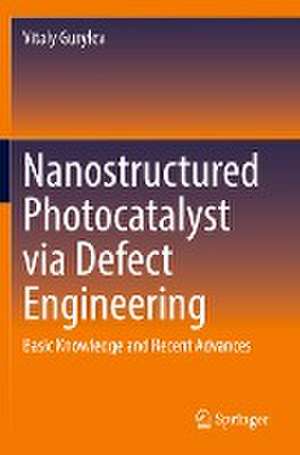Nanostructured Photocatalyst via Defect Engineering: Basic Knowledge and Recent Advances
Autor Vitaly Guryleven Limba Engleză Paperback – 28 oct 2022
| Toate formatele și edițiile | Preț | Express |
|---|---|---|
| Paperback (1) | 1054.38 lei 38-44 zile | |
| Springer International Publishing – 28 oct 2022 | 1054.38 lei 38-44 zile | |
| Hardback (1) | 1229.10 lei 22-36 zile | |
| Springer International Publishing – 28 oct 2021 | 1229.10 lei 22-36 zile |
Preț: 1054.38 lei
Preț vechi: 1387.34 lei
-24% Nou
Puncte Express: 1582
Preț estimativ în valută:
201.75€ • 211.21$ • 166.94£
201.75€ • 211.21$ • 166.94£
Carte tipărită la comandă
Livrare economică 02-08 aprilie
Preluare comenzi: 021 569.72.76
Specificații
ISBN-13: 9783030819132
ISBN-10: 3030819132
Pagini: 378
Ilustrații: XIX, 378 p. 76 illus., 73 illus. in color.
Dimensiuni: 155 x 235 mm
Greutate: 0.72 kg
Ediția:1st ed. 2021
Editura: Springer International Publishing
Colecția Springer
Locul publicării:Cham, Switzerland
ISBN-10: 3030819132
Pagini: 378
Ilustrații: XIX, 378 p. 76 illus., 73 illus. in color.
Dimensiuni: 155 x 235 mm
Greutate: 0.72 kg
Ediția:1st ed. 2021
Editura: Springer International Publishing
Colecția Springer
Locul publicării:Cham, Switzerland
Cuprins
Photocatalysis: fundamentals.- General principles of defect engineering.- Bulk vs surface defects.- Analysis of defects.- Case study I: Defect engineering of TiO2.- Case study II: Defect engineering of ZnO.- Case study III: Defect engineering of Ta2O5-, Ta3N5- and TaON-based nanostructures.- Case study V: Defect engineering of MoS2 and WS2 nanostructures.- Defect engineering of other nanostructured semiconductors .- Extrinsic defects in nanostructures semiconductors.- Comparison of extrinsic and intrinsic deficiencies.
Notă biografică
Dr. Vitaly Gurylev holds a M.S. in Chemical Engineering by Chung Yuan Christian University, Taiwan and a PhD in Materials Science and Engineering by National Tsing Hua University, Taiwan. After graduation in 2016, he spent three years to join several postdoctoral practices in the same institution and then relocated to neighboring National Synchrotron Radiation Research Center to become a part of Molecular Science Group while continue serving the same position. His research interest is mainly related to defect engineering and its application to build various nanostructured functional materials with tunable properties and characteristics that can be used in photocatalytic processing. Currently, he has published 13 papers in SCI journals of high impact index including one review and one Featured Article, 10 of which have designated him as first or corresponding author. Besides, his work has given rise to several prominent contributions to national and international conferences and also invited talks. He also was designated as outstanding reviewer by some SCI journals.
Textul de pe ultima copertă
This book helps readers comprehend the principles and fundamentals of defect engineering toward realization of an efficient photocatalyst. The volume consists of two parts, each of which addresses a particulate type of defects. The first, larger section provides a comprehensive and rigorous treatment of the behaviour and nature of intrinsic defects. The author describes how their controlled introduction and consequent manipulation over concentration, distribution, nature and diffusion is one of the most effective and practical methodologies to modify the properties and characteristics of target photocatalytic materials. The second part of the book explains the formation of extrinsic defects in the form of metallic and non-metallic dopants and gives a detailed description of their characteristics as this approach is also often used to fabricate an efficient photocatalyst. Filling the gap in knowledge on the correlation between introduction of defects in various semiconducting materials and their photocatalytic performance, the book is ideal for graduate students, academics and researchers interested in photocatalysts, defect engineering, clean energy, hydrogen production, nanoscale advanced functional materials, CO2 deactivation, and semiconductor engineering.
- Investigates the nature and behaviour of intrinsic and extrinsic defects in the most recognizable and promising semiconductor photocatalytic materials;
- Demonstrates how the advancement of structural, optical, electronic and electrical properties of photocatalytic materials can be achieved via introduction of defects;
- Illustrates application of defects engineering in building an efficient nanostructured photocatalyst;
- Compares intrinsic and extrinsic deficiencies in strict and accurate terms.
Caracteristici
Investigates the nature and behaviour of intrinsic and extrinsic defects in the most recognizable and promising semiconductor photocatalytic materials
Demonstrates how the advancement of structural, optical, electronic and electrical properties of photocatalytic materials can be achieved via introduction of defects
Illustrates application of defects engineering in building an efficient nanostructured photocatalyst
Compares intrinsic and extrinsic deficiencies in strict and accurate terms
Demonstrates how the advancement of structural, optical, electronic and electrical properties of photocatalytic materials can be achieved via introduction of defects
Illustrates application of defects engineering in building an efficient nanostructured photocatalyst
Compares intrinsic and extrinsic deficiencies in strict and accurate terms
